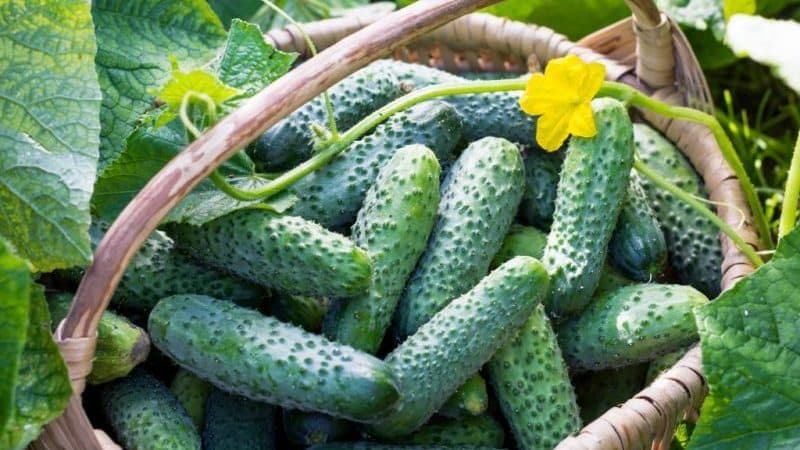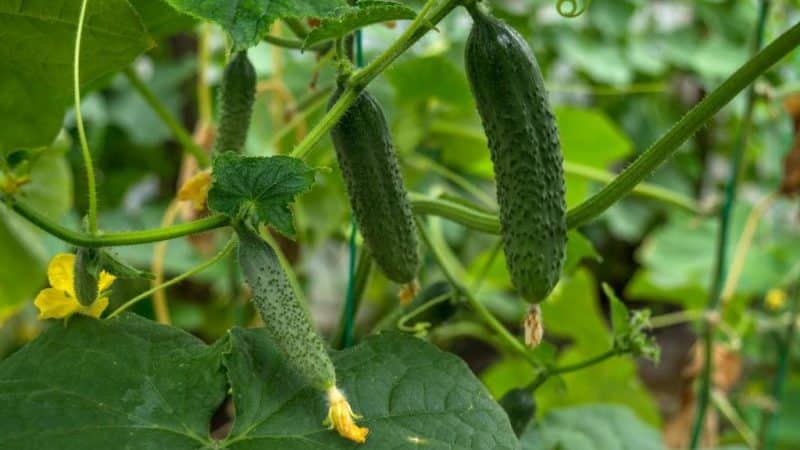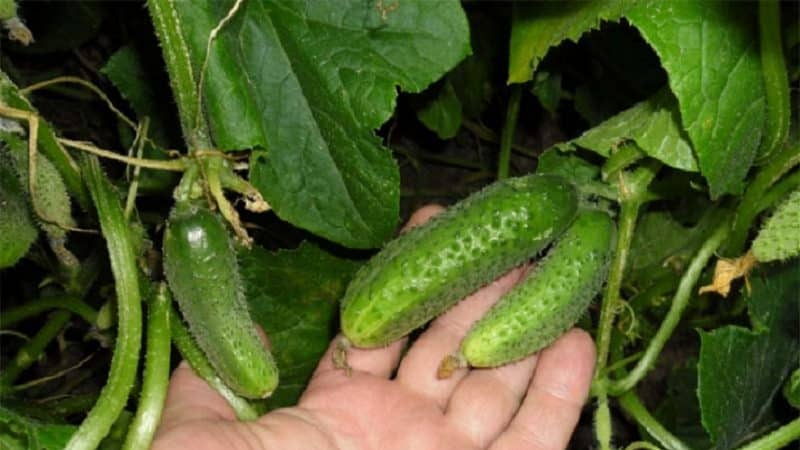Unpretentious cucumber “Lilliput f1”, which does not require pollination and produces a rich harvest
Every gardener wants to grow his own, the most fragrant and crunchy cucumbers “straight from the garden.” To ensure that the result does not disappoint, experienced summer residents advise purchasing proven, well-proven varieties and hybrids. One of these crops is Lilliput f1.
From the article you will learn what the advantages of this hybrid are and how to grow it correctly to get maximum yield.
Description
The parthenocarpic hybrid Lilliput f1 from the Gavrish seed company was included in the State Register of Breeding Achievements of Russia in 2008 and zoned for cultivation in greenhouse conditions in the middle zone.
Distinctive features
Lilliput f1 cucumbers are distinguished by medium branching and a predisposition to the formation of lateral determinate shoots. The leaves are medium in size, color ranges from green to dark green.
Fruit growth is slow, which is genetic. If you do not remove the cucumber from the vine in a timely manner, it retains its length within 7-9 cm and begins to grow in width, does not turn yellow for a long time, but the growth of new ovaries is inhibited.
Hybrid gherkin type, early ripening: the period from germination to the beginning of fruiting is less than 1.5 months. It has only female flowers that do not require pollination by insects.
Universal application: fresh and prepared. It tolerates transportation well and is kept fresh for a long time.

Composition, properties, benefits, calorie content
Cucumber has a unique composition - it consists of 95% structured water, which is extremely beneficial for the body. It has a calorie content of only 15 kcal per 100 g of product, contains 0.8 g of protein, 0.1 g of fat, 2.8 g of carbohydrates.
Cucumber is rich in beta-carotene, vitamins A, B, C, PP, microelements: potassium, magnesium, phosphorus, chromium, folic acid. Record holder for fiber content, useful for patients with atherosclerosis, coronary heart disease, and obesity.
Characteristics
Hybrid Liliput f1 is a medium-sized bush, branching, with small foliage. Each leaf axil contains 7-10 ovaries. The fruits are 8-9 cm in size, gherkin-type, large-tubercular, with white spines.
The weight of the cucumber is 80-100 g, and with rare harvesting it does not outgrow. The vegetable is green at the petiole, gradually becomes lighter towards the tip, and has small stripes. The shape of the cucumber is elongated, cylindrical.
The taste of cucumber is excellent: thin skin, juicy, crispy flesh without bitterness.
Fruiting begins at the end of June. The yield is 7-10 kg per m².
How to grow your own
It is not difficult to grow the Liliput cucumber yourself, taking into account the suggested recommendations.
Landing
Liliput f1 cucumbers are grown by seedlings or direct sowing in the ground. When growing seedlings, it is recommended to plant each seed separately in a peat or plastic cup with a retractable bottom, since the plant does not tolerate picking well. You can buy the soil or prepare it yourself: mix turf soil, humus and sand in a ratio of 3:2:1.
Fertile soil is disinfected with “Fitosporin” or by heating in the oven. Seeds are planted to a depth of 1-2 cm.Immediately after germination, the seedlings are placed in the brightest possible place, maintaining a thermal regime of 22-25 ° C. In the middle zone, planting seeds for seedlings should be done in mid-April.
The seedlings are planted in the greenhouse when the weather is warm. When planting, they try to injure the delicate root system of the cucumber as little as possible.
The soil in the greenhouse should be fertile, rich in organic matter, and moisture-retaining. Cucumber does not like heavy, acidic soil.
Sometimes gardeners make a “warm” bed by digging a pit 50-70 cm deep and placing manure, mown grass, and various plant debris on the bottom. As the mixture rots, it releases heat.
When sowing cucumber seeds directly into the ground, they are buried 1-2 cm and planted according to a 30x50 cm pattern. It is believed that cucumbers grown from seeds are stronger, but the start of fruiting is delayed.
Caring for cucumbers in a greenhouse
Cucumbers require regular, abundant watering, but without stagnation of water. Ventilation of the greenhouse is necessary. Favorable temperature for growing is 25-27 °C during the day, 18 °C at night. At temperatures below 15 °C, cucumber does not grow. In the event of late return frosts, additional arcs with covering material must be installed in the greenhouse.
It is necessary to regularly feed cucumbers with organic and mineral fertilizers. Timely weeding and loosening to a shallow depth are required so as not to damage the roots.
Features of cultivation and possible difficulties
A special feature of growing parthenocarpic hybrids is their pinching. In the axils of the first 4 leaves, shoots are blinded, the next 5-6 are left 20 cm and pinched, the next 5-6 are left 30-40 cm and pinched.
In parthenocarpic hybrids, the bulk of the cucumbers grow on the central trunk, so it is tied to a trellis.
 Difficulties in growing may arise for beginners when applying fertilizers.
Difficulties in growing may arise for beginners when applying fertilizers.
If the foliage is light green, it means the plant is lacking organic matter.
If the foliage is large, dark green, the cucumber blooms weakly, it means that the plant is overfed with nitrogen, potassium-phosphorus mineral fertilizers should be applied.
Cucumber needs regular feeding throughout the growing season.
Reference! Lack of ventilation in the greenhouse and dense plantings (the hybrid is highly branched) can lead to the development of various diseases and the appearance of pests.
Diseases and pests of cucumber
Hybrid Liliput f1 is genetically resistant to true and downy mildew, olive spot, and root rot.
With insufficient ventilation, soil contamination, watering with cold water, and temperature changes, the following diseases may develop:
- Downy mildew - the leaves turn yellow, then spots appear, the plant gradually dries out. Treatment with whey or spraying with Bordeaux mixture and soap solution helps.
- Cladosporiosis - brown spot, affects leaves and fruits. Develops when watered with cold water.
- Fusarium wilt - the lower leaves fade first, gradually the process spreads to the entire plant. The cause is a fungus that is often found in the soil. Trichodermin helps, which can be used to spray plants or water the soil.
- Anthracnose - brown spots on leaves, wet ulcers on cucumbers. Treatment is spraying with Bordeaux mixture.
The main pests of cucumbers in the greenhouse:
- spider mite - small, 0.3 mm in size, arachnid, which can be seen by small yellow dots on the leaves of cucumbers;
- whitefly - a white butterfly, 0.5 cm in size, its larvae carry a virus that covers the leaves with a sooty coating;
- thrips - a small insect that causes significant damage to plantings.
Spotted pests are combated with infusions of marigolds, garlic, onion peels and celandine along with green soap, which is sold in flower shops. If the infection has covered the entire greenhouse, use the insecticides “Aktara”, “Fufanon”, “Fitoverm”, “Aktellik”, and the biological products “Bitoxibacillin”, “Nemabakt”.
Harvesting and application
To obtain tender small cucumbers, it is recommended to collect them every day or every other day during the season. Although the cucumbers of this hybrid remaining on the bush do not overgrow much, they draw strength from the plant, and fewer new ovaries are formed.
Reference! Hybrid Lilliput f1 is universally used and ideal for any type of processing.
Advantages and disadvantages

The advantages of the hybrid include good taste and a small number of seeds in the fruit, early ripeness, high yield and ease of care. Lilliputian f1 is immune to many cucumber diseases. The fruits of the hybrid have an attractive appearance, are not prone to overgrowth, are universal in use, and are well transported.
Flaws:
- when grown in open ground and cross-pollinated, non-standard fruits may appear;
- the bush branches heavily, it is necessary to form the bush by pinching it;
- high cost of seeds; it is impossible to obtain your own seeds from a hybrid.
Reviews
Gardeners characterize Lilliput f1 as a hybrid that does not require special attention, bears fruit in unfavorable conditions, and has a pleasant taste.
Tatyana, Arkhangelsk: “I always buy seeds from the Gavrish company, I thought there was nothing better than the Zyatek and Mother-in-law seeds, but I accidentally bought Lilliput f1. I was amazed by this hybrid during fruiting: from the roots to the very top it was strewn with cucumbers, as in the photo on the Internet.”
Stanislav, Barnaul: “I plant this hybrid all the time and call it cucumbers “for the lazy.” I rarely go to the dacha, I often can’t water it, but the cucumbers still grow beautiful and tasty.”
Natalya, Lipetsk: “We love cucumbers very much, we plant them every year. We bought it to try and was attracted by the fact that it does not require pollination. I was pleased with the cucumbers: beautiful appearance, crispy flesh, not watery, thin skin. In salads it goes well with other vegetables – peppers and tomatoes.”
Conclusion
The Liliput f1 cucumber hybrid is early ripening, unpretentious and high-yielding. The taste of the fruit can be assessed as “excellent”. The hybrid is stable and always produces a harvest even in cold summers. Planting a hybrid on your site can be recommended to everyone, regardless of their level of training.